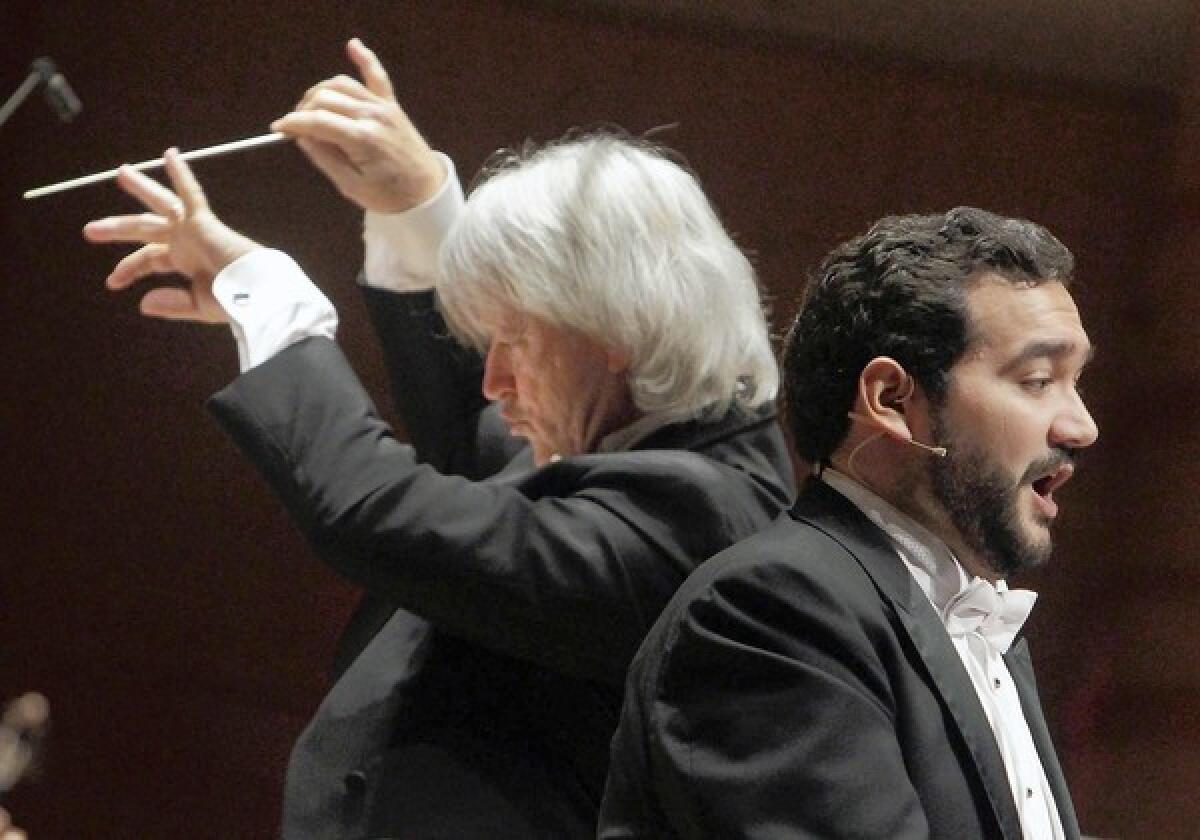Review: ‘Canciones de Lorca’ makes welcome return to Pacific Symphony

- Share via
The temptation for an orchestra to celebrate the opening of a concert hall by commissioning a major new work is obvious and irresistible. It’s also, more often than not, a bad idea.
Preparing a premiere is hard enough under normal circumstances. There is never enough rehearsal time, and composers frequently need to make changes once they hear their music in the flesh. A new acoustic environment will only confuse the instrumental matters. On top of that, the logistics of concert hall openings — the endless last-minute construction details and typical gala arrangement — can be crazy-making all by themselves. The safest bet is to seek out a new piece that is short and showy without being demanding.
So the Pacific Symphony’s music director, Carl St.Clair, took a significant risk seven years ago when he asked William Bolcom to write a substantial song cycle for Plácido Domingo that would help open the Renée and Henry Segerstrom Concert Hall in Costa Mesa. Along with all the above issues, the new hall has adjustable acoustical settings needing months, if not years, to learn how to use. Moreover, the world’s busiest singer arrived in town only a day before the premiere.
CHEAT SHEET: Fall arts preview
Against all odds, the Pacific Symphony got a powerfully expressive half-hour song cycle, “Canciones de Lorca,” tailor-made for Domingo musically, vocally and emotionally. He sang it with magnificent investment in tone and text. St.Clair impressively captured Bolcom’s stylistic versatility and light silver orchestral writing. It proved a memorable occasion.
Memory, unfortunately, was exactly what we were left with. After that single performance attended by a high-rolling gala crowd, the songs all but disappeared, with few further performances by Domingo or any other soloist. By now, Domingo has become a baritone and the work is no longer appropriate for him.
But Thursday night St.Clair finally brought back the “Canciones” with a young tenor, René Barbera. And this time, the songs will stick around. Not only is the program to be repeated Friday and Saturday, but Naxos record label arrived to record the “Canciones” for release some time next year.
PHOTOS: LA Opera through the years
In fact, it turns out that the Bolcom premiere in 2006 was even more fraught than the audience realized. In a post-concert panel discussion on stage Thursday, Bolcom and St.Clair revealed that they had to accommodate Domingo, then 65, adding slight pauses or measure repetitions to give his voice an occasional extra rest.
Professionalism and adrenaline may have made that performance a triumph, but St.Clair was cautious Thursday. Not only did he have a young singer at his disposal, but he also made Bolcom’s score the major work of an otherwise less demanding program that began with Joaquín Rodrigo’s “Concierto de Aranjuez” and five selections from Manuel De Falla’s “El Amor Brujo.”
It had been Domingo’s request that Bolcom use texts by Federico García Lorca, and seduction, sweet and sad, is a thread that runs through many of the lines. The cycle begins with “Balanza” (Balance), the tenor voice alone, singing of night’s constancy and day’s fickleness. Light and dark are another theme of the cycle.
GRAPHIC: Highest-earning conductors
Bolcom’s score explores various Spanish styles, particularly flamenco. The composer luxuriates in the slow, soft ravishment of Lorca’s most famous poem, “La Casada Infiel” (The Unfaithful Wife). The cycle turns disturbing and surreal with later poems – “Alba” (Dawn), “Danza de lúa Santiago” (Dance of the Moon), “Arboles” (Trees) and the heartbreaking “Soneto de la Dulce Queja” (Sonnet of the Sweet Complaint).
But then Bolcom does something striking by adding a second jazzy interlude, “Harlem 1929,” evoking the year the Spanish poet spent in New York. The final song “El Poeta Llega a La Habana” (The Poet Arrives in Havana) has an ethereal swing.
Barbera, who won first prize in Domingo’s Operalia competition in Moscow two years ago, almost sounds at moments, in the bright ring of his high notes, like a well-scrubbed young Domingo. He sang Bolcom’s songs securely, but a bit too squarely. He might have had first night nerves, these concerts being his first major recording, and he has two more chances to loosen up. He also needed a touch of miking to help his low notes cut through the orchestra, and that may have given his voice too much metal for songs more about experience than innocence.
Young soloists also appeared in the first half, and they too were impressive but overly careful. The fast-rising Chinese guitarist Xuefei Yang played suave music with clearheaded calculation. Mezzo-soprano Ola Rafalo brought a fine dusky quality to the vocal numbers in the Falla’s ballet but she, too, could be stiff.
St.Clair, though, provided the fire here and throughout the program. He also brought out a wealth of instrumental details displaying just how much the orchestra has grown into its hall the past seven years.
---------------------------
Pacific Symphony
Where: Renée and Henry Segerstrom Concert Hall, Costa Mesa
When: 8 p.m. Saturday
Cost: $25-$185
Info: (714) 755-5799 or https://www.pacificsymphony.org
More to Read
The biggest entertainment stories
Get our big stories about Hollywood, film, television, music, arts, culture and more right in your inbox as soon as they publish.
You may occasionally receive promotional content from the Los Angeles Times.











